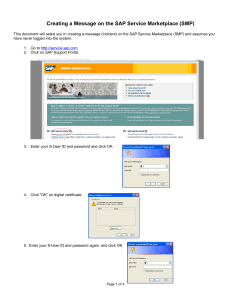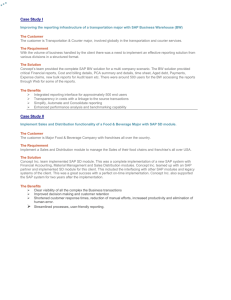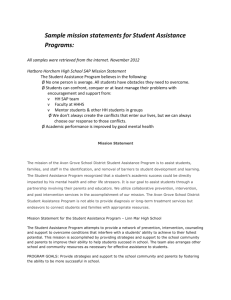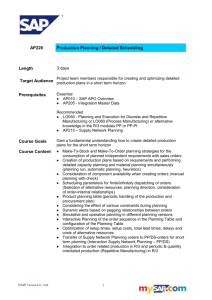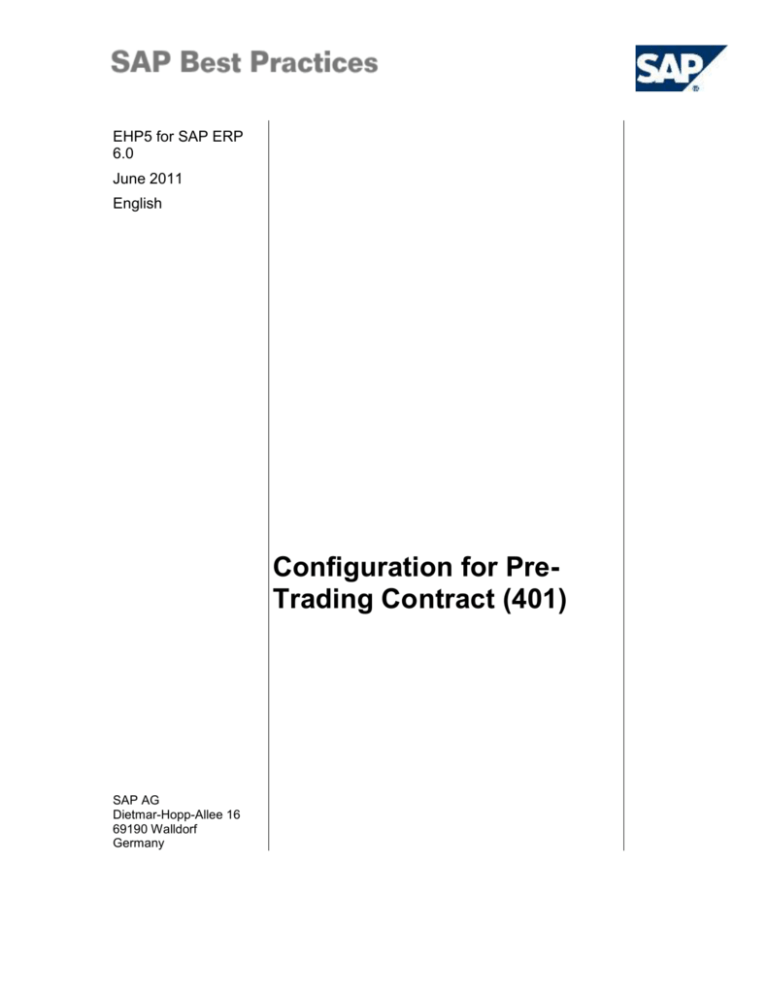
EHP5 for SAP ERP
6.0
June 2011
English
Configuration for PreTrading Contract (401)
SAP AG
Dietmar-Hopp-Allee 16
69190 Walldorf
Germany
SAP Best Practices
Pre-Trading Contract (401): Configuration Guide
Copyright
© 2011 SAP AG. All rights reserved.
No part of this publication may be reproduced or transmitted in any form or for any purpose without the express
permission of SAP AG. The information contained herein may be changed without prior notice.
Some software products marketed by SAP AG and its distributors contain proprietary software components of
other software vendors.
Microsoft, Windows, Excel, Outlook, and PowerPoint are registered trademarks of Microsoft Corporation.
IBM, DB2, DB2 Universal Database, System i, System i5, System p, System p5, System x, System z, System
z10, System z9, z10, z9, iSeries, pSeries, xSeries, zSeries, eServer, z/VM, z/OS, i5/OS, S/390, OS/390,
OS/400, AS/400, S/390 Parallel Enterprise Server, PowerVM, Power Architecture, POWER6+, POWER6,
POWER5+, POWER5, POWER, OpenPower, PowerPC, BatchPipes, BladeCenter, System Storage, GPFS,
HACMP, RETAIN, DB2 Connect, RACF, Redbooks, OS/2, Parallel Sysplex, MVS/ESA, AIX, Intelligent Miner,
WebSphere, Netfinity, Tivoli and Informix are trademarks or registered trademarks of IBM Corporation.
Linux is the registered trademark of Linus Torvalds in the U.S. and other countries.
Adobe, the Adobe logo, Acrobat, PostScript, and Reader are either trademarks or registered trademarks of
Adobe Systems Incorporated in the United States and/or other countries.
Oracle is a registered trademark of Oracle Corporation.
UNIX, X/Open, OSF/1, and Motif are registered trademarks of the Open Group.
Citrix, ICA, Program Neighborhood, MetaFrame, WinFrame, VideoFrame, and MultiWin are trademarks or
registered trademarks of Citrix Systems, Inc.
HTML, XML, XHTML and W3C are trademarks or registered trademarks of W3C ®, World Wide Web
Consortium, Massachusetts Institute of Technology.
Java is a registered trademark of Sun Microsystems, Inc.
JavaScript is a registered trademark of Sun Microsystems, Inc., used under license for technology invented and
implemented by Netscape.
SAP, R/3, SAP NetWeaver, Duet, PartnerEdge, ByDesign, SAP BusinessObjects Explorer, StreamWork, and
other SAP products and services mentioned herein as well as their respective logos are trademarks or
registered trademarks of SAP AG in Germany and other countries.
Business Objects and the Business Objects logo, BusinessObjects, Crystal Reports, Crystal Decisions, Web
Intelligence, Xcelsius, and other Business Objects products and services mentioned herein as well as their
respective logos are trademarks or registered trademarks of Business Objects Software Ltd. Business Objects
is an SAP company.
Sybase and Adaptive Server, iAnywhere, Sybase 365, SQL Anywhere, and other Sybase products and services
mentioned herein as well as their respective logos are trademarks or registered trademarks of Sybase, Inc.
Sybase is an SAP company.
© SAP AG
Page 2 of 14
SAP Best Practices
Pre-Trading Contract (401): Configuration Guide
All other product and service names mentioned are the trademarks of their respective companies. Data
contained in this document serves informational purposes only. National product specifications may vary.
These materials are subject to change without notice. These materials are provided by SAP AG and its affiliated
companies ("SAP Group") for informational purposes only, without representation or warranty of any kind, and
SAP Group shall not be liable for errors or omissions with respect to the materials. The only warranties for SAP
Group products and services are those that are set forth in the express warranty statements accompanying
such products and services, if any. Nothing herein should be construed as constituting an additional warranty.
© SAP AG
Page 3 of 14
SAP Best Practices
Pre-Trading Contract (401): Configuration Guide
Icons
Icon
Meaning
Caution
Example
Note
Recommendation
Syntax
External Process
Business Process Alternative/Decision Choice
Typographic Conventions
Type Style
Description
Example text
Words or characters that appear on the screen. These include field
names, screen titles, pushbuttons as well as menu names, paths and
options.
Cross-references to other documentation.
Example text
Emphasized words or phrases in body text, titles of graphics and tables.
EXAMPLE TEXT
Names of elements in the system. These include report names,
program names, transaction codes, table names, and individual key
words of a programming language, when surrounded by body text, for
example, SELECT and INCLUDE.
Example text
Screen output. This includes file and directory names and their paths,
messages, source code, names of variables and parameters as well as
names of installation, upgrade and database tools.
EXAMPLE TEXT
Keys on the keyboard, for example, function keys (such as F2) or the
ENTER key.
Example text
Exact user entry. These are words or characters that you enter in the
system exactly as they appear in the documentation.
<Example text>
Variable user entry. Pointed brackets indicate that you replace these
words and characters with appropriate entries.
© SAP AG
Page 4 of 14
SAP Best Practices
Pre-Trading Contract (401): Configuration Guide
Contents
1
2
Purpose ......................................................................................................................................... 6
Preparation .................................................................................................................................... 6
2.1
Prerequisites .......................................................................................................................... 6
3 CONFIGURATION SETTINGS ..................................................................................................... 6
3.1
Define Purchasing Group ....................................................................................................... 6
3.2
Define Sales Group ................................................................................................................ 7
3.3
Define Trading contract Type ................................................................................................. 8
3.4
Assign document type to item category ................................................................................. 9
3.5
Output Determination and Smartforms ................................................................................ 10
© SAP AG
Page 5 of 14
SAP Best Practices
Pre-Trading Contract (401): Configuration Guide
1 Purpose
This configuration guide provides the information you need to set up the configuration of this building
block manually.
If you do not want to configure manually and prefer an automated installation process using the SAP
Best Practices Installation Assistant and other tools, refer to the SAP Best Practices Quick Guide.
2 Preparation
2.1 Prerequisites
Before you start installing this building block, you must install prerequisite building blocks. For more
information, see the Building Block Prerequisite Matrix (Prerequisites_Matrix_[xx]_[yy]_ [zz].xls; the
placeholder [xx] depends on the SAP Best Practices version you use, e.g. GTM refers to the SAP
Best Practices for Global Trade Management, [yy] depends on the language version, e.g. EN for
English language, and [zz] depends on the country version, e.g. DE for Germany:
Prerequisites_Matrix_GTM_EN_DE.xls). This document can be found on the SAP Best Practices
documentation DVD in the folder ..\[xx]_[zz]\Documentation\; ([xx] depends on the SAP Best
Practices version and [zz] depends on the country version).
3 CONFIGURATION SETTINGS
3.1 Define Purchasing Group
Use
The purchasing group in GTM has the same naming as purchasing group in MM, but these are different
org-elements.
GTM Purchasing groups control which pricing schema is used for calculating the purchase price in a
trading contract and which purchasing document type is used for the purchase order.
It helps to determine the price determination schema used for calculating the purchasing price in a trading
contract as well as the document type used for one-sided follow-on documents.
Procedure
Carry out the following steps:
1. Access the activity using one of the following navigation options:
IMG Menu
© SAP AG
Logistics General SAP Global Trade Management Trading
Page 6 of 14
SAP Best Practices
Pre-Trading Contract (401): Configuration Guide
Contract Purchasing Group
Transaction Code
SPRO or W_WB2B_0G06
2. On the Change View “Trading Contract – Purchasing Grouping Definition“: Overview screen,
select the entry 0001 for Stock shipment and choose Copy As
Field name
Description
User action and values
Comment
Trading Contract
Purchasing Group
Purchasing Group
Standard for Stock
Shipment
YN03
Copy of
0001 for
Stock
shipment
3. Choose Enter and confirm the Dependent entries for copy control dialog box.
4. Save your settings.
5.
Choose Back (F3).
Result
The purchasing Group YN03 has been created.
3.2 Define Sales Group
Use
The sales group in GTM has the same naming as sales group in SD but these are different org-elements.
In this step, you create your GTM sales groups. You also define values and procedures used by each
GTM sales group when creating a trading contract, especially the sales order type for SD.
Procedure
Carry out the following steps:
1. Access the activity using one of the following navigation options:
IMG Menu
Logistics General Global Trade Management Trading
Contract Sales Group
Transaction Code
SPRO or W_WB2B_0G07
2. On the Change View “Trading Contract – Sales Grouping Definition“: Overview screen, select
the entry 0001 Standard and choose Copy As.
Field name
Description
User action and values
Comment
Sales Group
Sales Group
YN03
Copy of
0001
© SAP AG
Page 7 of 14
SAP Best Practices
Pre-Trading Contract (401): Configuration Guide
Field name
Description
User action and values
Sales Doc. Type
Trade Contract
Order YN04 for
drop shipment
YN04
Comment
3. With the Sales Group following settings like Default values, Price Determination schema as well as
sales document type belong to a trading contract are defined.
4. Choose Enter and confirm the Dependent entries for copy control dialog box.
5. Save your settings.
6.
Choose Back (F3).
Result
The Sales Group YN01 and YN02 have been created.
3.3 Define Trading contract Type
Use
The trading contract type YN00 is a pre-trading contract and is used as a Master Agreement with
quantity update or as copy template carrying all necessary data. From Pre Contract no follow on
documents will be created. Trading contracts can be created in reference to a Pre Contract in which
quantity will be updated.
Procedure
Carry out the following steps:
1. Access the activity using one of the following navigation options:
IMG Menu
Logistics General SAP Global Trade Management
Trading Contract Define Trading Contract Type
Transaction Code
SPRO
2. On the Change View “Trading Contract: Trading Contract Type Definition“: Overview screen,
select the entry 0000 Precontract and choose Copy As.
Field name
Description
User action and values
Comment
Trading contract Type
Pre contract
YN00
For Pre-contract
no follow-on
documents are
created in SD
and MM
Item category
Drop shipment
YN02
© SAP AG
Page 8 of 14
SAP Best Practices
Field name
Pre-Trading Contract (401): Configuration Guide
User action and values
Comment
Ext. Number active
A external number active
On creation of tc
internal number
is displayed
GTM Sales Group
YN03
GTM Purchasing
Group
YN03
Partner determination
Description
GTM both-sides
GH01
Pricing
1
DefaultApplicStatus
K Open
Checks,
Incompleteness Group
Y1
Assign Group
Characteristic Trading contract Grp
YN01
Standard Pricing
Incompleteness
(Two-sided)
3. Save your settings.
4. Choose Back (F3).
Result
The trading contract YN00 has been created.
3.4 Assign document type to item category
Use
This setting allows you to assign item categories to trading contract types. You can also define any
item category as a default; which can be changed manually in a document prior to release.
Procedure
Carry out the following steps:
1. Access the activity using one of the following navigation options:
IMG Menu
Logistics General SAP Global Trade Management
Trading Contract Assign document type to item category
Transaction Code
SPRO
2. On the Change View “Trading Contract: Document Type/Item Category Assignment“: Overview
screen, enter following entries YN00 Precontract .
© SAP AG
Page 9 of 14
SAP Best Practices
Pre-Trading Contract (401): Configuration Guide
Trading contract
Type
Item category
Name
YN00
YN01
Drop Shipment
YN00
YN02
Stock Shipment
Default
3. Save your settings.
4. Choose Back (F3).
Result
The trading contract YN00 has been assigned.
3.5 Output Determination and Smartforms
3.5.1 Create BP Smartforms
Use
Process this activity to make sure that the smart forms are copied into your BP namespace.
Procedure
Carry out the following steps:
1. Access the activity using one of the following navigation options:
IMG Menu
Tools Form Printout Smartforms
Transaction Code
SMARTFORMS
2. On the SAP Smart Forms: Initial Screen, choose Copy (Ctrl + F5).
3. In Source Object, enter the name of the smart form you want to copy.
4. In Target Object, enter the new name in your customer namespace.
Source Object
Target Object
Trade Contract (WT)
/SMB15/GT_WB_CUSTOMER
/SMB15/GT_WB_VENDOR
YNGT_WB_CUSTOMER
YNGT_WB_VENDOR
During developmet the /SMB15/AA_ object are created, operational use will be made of
YNAA_objects
3.5.2 Copying Standard Print Programs into BP Namespace
Use
Process this activity to make sure that the smart form print programs are copied into your customer
namespace.
Procedure
© SAP AG
Page 10 of 14
SAP Best Practices
Pre-Trading Contract (401): Configuration Guide
Carry out the following steps:
1. Access the activity using one of the following navigation options:
Transaction Code
SE38
2. On the ABAP Editor: Initial Screen enter the source program.
3. Choose Copy (Ctrl + F5).
4. In the target program, enter the name of the new program.
Source Program
Target Program
RWB2NAST
/SMB15/ GT_RWB2NAST
Result
The Print Program has been created.
3.5.3
Activating Print Programs
Use
Process this activity to make sure that the Print Programs are active.
Procedure
Carry out the following steps:
1. Access the activity using one of the following navigation options:
2.
3.
4.
5.
IMG Menu
System Services Reporting
Transaction Code
SA38
On the ABAP Editor: Initial Screen enter the Print Program.
Choose Match (Shift + F9).
If a dialog box occurs, choose Select all and then choose Continue.
Repeat the step for the following Print Programs.
Print Program
/SMB15/ GT_RWB2NAST
6. Go back to continue the configuration.
Result
The Print Programs are activated.
3.5.4 Assigning Trade Contract Forms
Use
Process these activities to configure the Trade Management Smart Forms.
Procedure
Carry out the following steps:
1. Access the activity using one of the following navigation options:
© SAP AG
Page 11 of 14
SAP Best Practices
Pre-Trading Contract (401): Configuration Guide
NACE
Transaction Code
2. On the Conditions for output type screen, select the application type (for example WT for
Trading Contract) in the application column and choose Output types (F5).
3. On the Display View “Output type”: Overview screen, choose the Change mode to change the
configuration.
4. Choose the output type (for example WTHC for Header Message Customer) and double-click on
processing routines in the left frame Dialog structure.
5. Choose New Entries and enter the following data:
Output Type
WTHC
Application
WT
Medium
1 (Print output)
Program
YNGT_RWB2NAST
Form routine
ENTRY_TRCON_HEAD_CUSTOMER
SmartForm
YNGT_WB_CUSTOMER
6. Save your settings.
7. Repeat procedure 4 - 6 for the documents specified below:
Description
Output
Type
Applica Mediu Program
tion
m
Form routine Smart Form / Form
Header
Message
Customer
WTHC
WT
1
YNGT_RWB2NAST
ENTRY_TRC YNGT_WB_CUSTOMER
ON_HEAD_C
USTOMER
Header
Message
Vendor
WTHV
WT
1
YNGT_RWB2NAST
ENTRY_TRC YNGT_WB_VENDOR
ON_HEAD_V
ENDOR
3.5.5
Assign Output Procedure to Purchasing Group
Use
In this step, you define the output procedure to be used by the trading contract at header and item level.
Procedure
Carry out the following steps:
1. Access the activity using one of the following navigation options:
IMG Menu
Logistics - General SAP Global Trade Management Trading
Contract Purchasing Group
Transaction Code
SPRO
© SAP AG
Page 12 of 14
SAP Best Practices
Pre-Trading Contract (401): Configuration Guide
2. On the Change View Trading Contrac: Purchasing Group Definition:Overview screen, locate
and double click on the YN03 - Grp. for Precontract row.
3. In the Message Section enter in the field Message Schema for Vendor the entry WTHV00.
4. Choose Save (Ctrl +S)
5. Choose Back (F3).
6. Repeat procedure 2 - for the documents specified below:
PurchasingGRP
Description
Message Schema for Vendor
the entry
YN03
Grp. for Precontract
WTHV00
3.5.6
Assign Output Procedure to Sales Group
Use
In this step, you define the output procedure to be used by the trading contract at header and item level.
Procedure
Carry out the following steps:
1. Access the activity using one of the following navigation options:
IMG Menu
Logistics - General SAP Global Trade Management Trading
Contract Sales Group
Transaction Code
SPRO
2. On the Change View Trading Contrac: Purchasing Group Definition:Overview screen, locate
and double click on the YN03 - Grp. for Precontract row.
3. In the Message Section enter in the field Message Schema Customer the entry WTHC00
4. Choose Save (Ctrl +S)
5. Choose Back (F3).
3.5.7
Output Control Data Records for Customer Messages for
Trade Management
Use
The purpose of this activity is to create the output control records customer messages for Trade
Management
Procedure
1. Access the transaction using the following transaction code:
SAP ECC menu
Logistics Global Trade Management Trading
Contract Environment Messages Edit Create
Transaction code
WWTA
© SAP AG
Page 13 of 14
SAP Best Practices
Pre-Trading Contract (401): Configuration Guide
2. On the Create Condition Records (Head.mess.Customer): Fast entry screen, make the following
entries:
Field Name
Description
User Action and Values
Comment
WTHC
Condition Type
3. Choose Key Combination.
4. Make the following entries:
Sales
Organization
Distribution
Channel
Division
Customer
Partner
Function
Medium
Dispatch
Time
1000
30
10
GTMDE01
SH
1
4
1100
30
10
GTMUS01
SH
1
4
Lang.
5. Choose Communication and enter the required output device, choose Print Immediately and
Release after Output.
6. Save your entries.
3.5.8
Output Control Data Records for Vendor Messages for
Trade Management
Use
The purpose of this activity is to create the output control records vendor messages for Trade
Management
Procedure
1. Access the transaction using the following transaction code:
SAP ECC menu
Logistics Global Trade Management Trading
Contract Environment Messages Edit Create
Transaction code
WWTA
2. On the Create Condition Records (Head.mess.Vendor): Fast entry screen, make the following
entries:
Field Name
Description
User Action and Values
Comment
WTHV
Condition Type
3. Choose Key Combination.
4. Make the following entries:
PurchaseOrg
anization
Invoicing
Party
Partner
Function
Medium
Dispatch
Time
1000
GTMCN01
VN
1
4
Lang.
5. Choose Communication and enter the required output device, choose Print Immediately and
Release after Output.
6. Save your entries.
© SAP AG
Page 14 of 14



